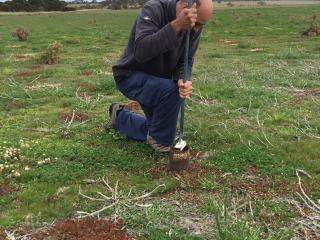Western Australia
January 23, 2023

Department of Primary Industries and Regional Development officer Paul Sanford taking paddock samples in late 2017.
Western Australian researchers have published key findings from five years of research into a strain of soybean dwarf virus (SbDV) impacting subterranean clover pastures.
The virus came to the attention of WA growers in 2017 when it was linked to ‘red leaf syndrome,’ which resulted in severe pasture losses in southern and central agricultural areas.
Department of Primary Industries and Regional Development (DPIRD) research scientist Ben Congdon said glasshouse trials had identified key aphid species that could spread the disease, the host range in pasture legumes and which grain legume crops may be susceptible.
“Genome sequencing on virus samples collected between 2017 to 2022 on the south coast showed that sub-clover infecting SbDV isolates have a similar genetic profile, and are likely belong to the same strain,” Dr Congdon said.
“The pea aphid and green peach aphid were identified as the key aphids responsible for transmission of this identified strain of the virus in WA.
“The virus spread is likely to depend significantly on the local abundance and movement patterns of these aphid species.
“Blue green aphid, a common aphid species in Australian grain and pasture legume crops, did not transmit the virus.”
Dr Congdon said research also broadened the known host range of SbDV among other pasture legume and weed species, including previously unknown hosts such as French serradella.
“Many of these alternative hosts do not produce obvious symptoms meaning they can act as concealed sources of infection for spread into more economically important hosts such as sub-clover and grain legumes,” he said.
Dr Congdon said the department’s research suggested SbDV could also cause substantial damage if it spreads into grain legume crops.
“We found chickpea, field pea, lentil and faba bean can incur substantial damage from SbDV infection under glasshouse conditions so this is something we need to monitor in the field,” he said.
Another key outcome from the work was the development of new molecular diagnostic tools that better equip the industry and DPIRD to respond to future SbDV outbreaks.
The research findings were recently published in the scientific journal, Archives of Virology, and will be used to update management advice for growers.
More information, including how to identify and manage the impacts of subterranean clover red leaf syndrome, is available from the department website www.agric.wa.gov.au search for ‘red leaf syndrome’.